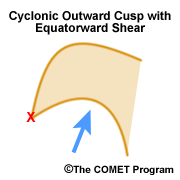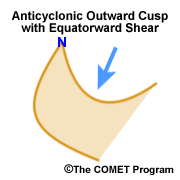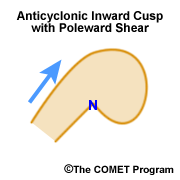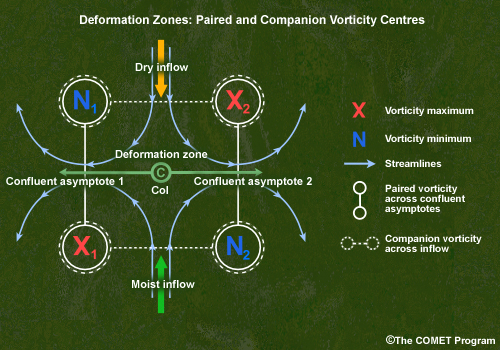Dynamic Feature Identification from Satellite Imagery
Glossary of Terms
A B C D E F G H I J K L M N O P Q R S T U V W X Y Z
A
- advection jets
-
Curved axes of maximum winds. Curved flows typically advect significant amounts of vorticity. (also see channeled jets)
Characteristics: If the flow curves cyclonically, the vorticity maximum associated with the flow is enhanced. The vorticity maximum area to the left of the cyclonically curved flow looking downstream transforms into a larger and more intense positive vorticity centre. Significant positive vorticity advection occurs downstream from this intense positive vorticity centre. The lobe of vorticity minima to the right of the flow weakens and is typically replaced by a short-wave trough as the flow becomes more cyclonically curved. Large and well-defined convex deformations zones are associated with a large and intense vorticity maximum which is typically associated with a strong companion vorticity minima downstream from the area of positive vorticity advection. A large comma moisture pattern is associated with an advection jet.
If the flow turns anticyclonically, the vorticity minimum associated with the flow is enhanced. The vorticity minimum lobe to the right of the anticyclonically curved flow looking downstream transforms into a larger and more intense negative vorticity centre. Significant negative vorticity advection occurs downstream from this intense negative vorticity centre. The lobe of vorticity maxima to the left of the flow weakens and is typically replaced by a short-wave ridge as the flow becomes more anticyclonically curved.
- air mass
-
An air mass, by definition, is a large dome of air which has similar horizontal temperature and moisture characteristics. Often a front separates two different air masses. Fronts are very narrow zones of transition. In other words, temperatures can change dramatically with short horizontal distances near fronts. Fronts are usually anywhere from 10 kilometers to hundreds of kilometers wide, while air masses can be thousands of kilometers wide.
- Alberta Clipper
-
A fast moving low pressure system that moves southeast out of the Canadian Province of Alberta (southwest Canada) through the Plains, Midwest, and Great Lakes region of the U.S. usually during the winter. This low pressure area is usually accompanied by light snow, strong winds, and colder temperatures. Another variation of the same system is called a "Saskatchewan Screamer". Alberta Clippers typically move too fast to bring warning criteria snow accumulations.
- anticomma cloud
-
Anticomma is the mirror reflection of the comma cloud in both a physical and dynamical sense. The comma cloud is created by a cyclonic rotation while the anticomma is created by anticyclonic rotation.
- anticyclonic rotation
-
Rotation in the opposite sense as the Earth's rotation, i.e., clockwise in the Northern Hemisphere as would be seen from above. The opposite of cyclonic rotation.
- atmospheric blocking
-
Stagnation of weather patterns when atmospheric patterns tend to repeat themselves. In the case of atmospheric blocking, the same pattern repeats for several days to even weeks. It is important to recognize a blocking pattern in its initial development allowing accurate prediction well into the future. Atmospheric blocking is best seen on upper air analysis and forecast charts. Blocking over large regions is most common with high-pressure since high pressure covers a large spatial area and tends to move slower than low pressure. In some instances, low pressure can also cause an atmospheric block. The five best known types of blocks are the omega block, the Rex block, the Ring of Fire, split flow, and the cut-off low.
- axis of contraction
-
The axis of a deformation zone along which the atmosphere is contracting. It is perpendicular to the axis of dilatation.
- axis of dilatation
-
The axis of a deformation zone along which the atmosphere is stretching. It is perpendicular to the axis of contraction. In satellite meteorology, the col and both the downstream and upstream confluent asymptotes comprise the axis of dilatation.
- axis of maximum winds
-
Synonymous with jet stream. Relatively strong winds concentrated within a narrow stream in the atmosphere. While this term may be applied to any such stream regardless of direction (including vertical), it is coming more and more to mean only a quasi-horizontal jet stream of maximum winds embedded in the midlatitude westerlies and concentrated in the high troposphere.
C
- channeled jets
-
Straight axes of maximum winds. Speed shear to the left of a channeled jet looking downstream is responsible for an elongated lobe of maximum vorticity. (also see advection jets)
-
Characteristics: Individual vorticity maxima within this lobe are typically chained together as a string of weak, elongated and small vorticity centres. Positive vorticity advection is minimal. Very small and subtle "backward S" deformation zones link the chain of weak vorticity maxima associated with these channeled jets. A chain of comma moisture patterns reveal a chain of vorticity maxima. Speed shear to the right of a channeled jet looking downstream, is responsible for an elongated lobe of minimum vorticity. Individual vorticity minima within this lobe are also typically chained together as a string of weak, elongated and small vorticity centres. Negative vorticity advection is minimal. Very small and subtle "S" deformation zones link the chain of weak vorticity minima associated with these channeled jets. A chain of anticomma moisture patterns reveal a chain of vorticity minima.
- closed upper level low
-
Sometimes a polar air mass will break away from the source region. This creates a region of colder air in the low levels surrounded on all sides by warmer air. The vortex nature of the low prevents warmer air from moving into the low. Since heights are lower in colder air and the difference in thickness between warm and cold air amplifies with height, height troughs with several closed height contours can occur aloft in these situations.
- col
-
The intersection of the axis of contraction and the axis of dilatation. The area from which the flow diverges along a deformation zone. Also referred to as neural points.
- comma cloud
-
A cloud formation that resembles a comma (in the northern hemisphere). Its shape is the result of cyclonic rotation.
- confluence
-
A pattern of wind flow in which air flows inward toward an axis oriented parallel to the general direction of flow. It is the opposite of difluence. Confluence is not the same as convergence. Winds often accelerate as they enter a confluent zone, resulting in speed divergence that offsets the (apparent) converging effect of the confluent flow.
- confluent asymptotes
-
One branch of the axis of dilatation extending outward from the col.
- convergence
-
An atmospheric condition that exists when the winds cause a horizontal net inflow of air into a specified region. Divergence is the opposite, where winds cause a horizontal net outflow of air from a specified region.
- convergence line
-
(also known as: asymptote of convergence) A horizontal line denoting horizontal convergence of airflow.
- C.S.I.
-
(not the CSI of instability) Creative Satellite Investigation: because anything else is a "crime". It is a crime not to do analysis and diagnosis as that comprises the basis of the science of meteorology. Satellite data is just one of the data sources. But since satellites have high and ever increasing resolution in both time and space, it should be the primary data source.
- curvature vorticity
-
The component of the relative vorticity depending on the curvature of the streamlines.
- cusps
-
A pointed projection formed by the intersection of two arcs; a point where two arcs or branches of a curve intersect. Refers to the point in a comma or anticomma cloud which indicates the position of the related vorticity maximum or minimum. This point is often also the point of inflection in a comma or anticomma pattern.
Examples:
 An outwardly pointed
projection formed by the intersection of two cyclonically curved arcs. In meteorology, a cyclonic
outward cusp is created by westerly speed shear that is equatorward of the cusp which marks the
location of a vorticity maximum.
An outwardly pointed
projection formed by the intersection of two cyclonically curved arcs. In meteorology, a cyclonic
outward cusp is created by westerly speed shear that is equatorward of the cusp which marks the
location of a vorticity maximum. An
inwardly directed point where two cyclonically curved arcs intersect. In meteorology a cyclonic inward
cusp is created
by easterly speed shear that is poleward of the cusp which marks the location of a vorticity maximum.
An
inwardly directed point where two cyclonically curved arcs intersect. In meteorology a cyclonic inward
cusp is created
by easterly speed shear that is poleward of the cusp which marks the location of a vorticity maximum.
 An outwardly
pointed projection formed by the intersection of two anticyclonically curved arcs. In meteorology an
anticyclonic outward cusp is created by easterly speed shear that is equatorward of the cusp which
marks the location of a vorticity minimum.
An outwardly
pointed projection formed by the intersection of two anticyclonically curved arcs. In meteorology an
anticyclonic outward cusp is created by easterly speed shear that is equatorward of the cusp which
marks the location of a vorticity minimum. An
inwardly directed point where two anticyclonically curved arcs intersect. In meteorology an
anticyclonic inward cusp
is created by westerly speed shear that is poleward of the cusp which marks the location of a
vorticity minimum.
An
inwardly directed point where two anticyclonically curved arcs intersect. In meteorology an
anticyclonic inward cusp
is created by westerly speed shear that is poleward of the cusp which marks the location of a
vorticity minimum.
- cut-off low
-
Cut off lows commonly occur when the upper level winds shift to a higher latitude and leave a circulating low pressure behind. Several height contours encircle the low at upper levels. Cut-off lows outside the flow of the jet stream can persist for several days, bringing several days of rainfall underneath the areas they park. A cut-off low is vertically stacked meaning that the center of the low is at about the same location at each level in the atmosphere.
- cyclonic circulation
-
(or cyclonic rotation) - Circulation (or rotation) which is in the same sense as the Earth's rotation, i.e., counterclockwise in the Northern Hemisphere as would be seen from above. Nearly all storms and strong or violent tornadoes exhibit cyclonic rotation, but some smaller vortices, sometimes rotate anticyclonically (clockwise).
D
- divergence
-
The expansion or spreading out of a vector field; usually said of horizontal winds. It is the opposite of convergence.
E
- equatorial shear
-
Equatorial Shear is when the shear generating a dynamic feature is located between that feature and the earth’s equator. This is true whether the feature is located in the northern or southern hemisphere.
- If the feature is a vorticity maximum (cyclonic vorticity) this means that the equatorial shear must result from a westerly wind maximum located between the vorticity maximum and the equator. This applies in both hemispheres.
- If the feature is a vorticity minimum (anticyclonic vorticity) this means that the equatorial shear must result from an easterly wind maximum located between the vorticity maximum and the equator. This also applies in both hemispheres.
F
The System relative frame of reference is attached to the atmosphere. The system relative frame of reference allows the examination of the relative motions and interactions of dynamic features. The origin of this system relative frame of reference in a particular area moves at the mean speed of the atmospheric flow in that same area. The interaction of dynamic features in this system relative frame of reference is paramount to the diagnosis of their current and future location, orientation, size, shape and intensity. In the system relative frame of reference, the specific geographical locations of the dynamic features are irrelevant. This is one reason why the geographical background can be toggled on and off in the satellite palette.
The Earth relative frame of reference is attached to the earth. The earth frame of reference is required to identify when circulations transition from open troughs and ridges to closed lows and highs. This transition occurs when moisture elements move upstream in the earth frame of reference. The transition from open troughs and ridges to closed lows and highs can not be diagnosed in the system relative frame of reference as they would simply appear as more intense circulations.
P
- point of inflection:
-
A point on a curve separating a concave arc (inflow) from a convex arc (outflow). This point is also considered a cusp.

- poleward shear
-
Poleward shear is when the shear generating a dynamic feature is located between that feature and the closest earth’s pole. This is true whether it be the earth’s north or south pole.
- If the feature is a vorticity maximum (cyclonic vorticity) this means that the poleward shear must result from an easterly wind maximum located between the vorticity maximum and the closest pole. This applies in both hemispheres.
- If the feature is a vorticity minimum (anticyclonic vorticity) this means that the poleward shear must result from a westerly wind maximum located between the vorticity minimum and the closest pole. This also applies in both hemispheres.
U
V
- vexed
-
Causing difficulty in finding an answer or solution; much disputed; "the vexed issue of priorities"; "we live in vexed and troubled times"
- vorticity
-
A measure of the local rotation in a fluid flow. In weather analysis and forecasting, it usually refers to the vertical component of rotation (i.e., rotation about a vertical axis) and is used most often in reference to synoptic scale or mesoscale weather systems. By convention, positive values indicate cyclonic rotation.
- vorticity centre, paired and companion
-

-
Paired vorticity centres are a vorticity maximum and a vorticity minimum that both straddle a confluent asymptote of a deformation zone.
Companion vorticity centres are a vorticity maximum and a vorticity minimum that both straddle an inflow along the axis of contraction to a deformation zone.
W
- WCB - warm conveyor belt
-
A narrow stream of air that transports large amounts of heat, moisture, and westerly momentum.
- water vapour imagery
-
The infrared water vapour channel is located at 6.7 microns where the earth's emitted spectrum is highly attenuated by water molecules. Thus, this channel senses radiation from the mid- and upper-levels of the atmosphere, from both water vapour and clouds. Because water vapour is transported by atmospheric circulations, it allows the detection of features in the mesoscale flow as well as hemispheric patterns.
Some of the key attributes of the use of water vapour imagery are:
- Very sensitive to moisture
- Shows variations in upper tropospheric moisture
- Typically senses upper half of troposphere; higher in moist and lower in dry regions
- Atmospheric wave structures are very apparent; short waves readily seen
- Tracking features in sequences of water vapour images useful for inferring atmospheric motion
For a more complete overview of the GOES water vapour channel as well as other important GOES channels, please visit the COMET module: Satellite Meteorology: GOES Channel Selection.